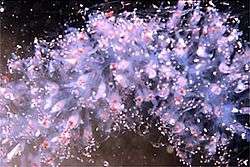Siphonophorae
| Siphonophores | |
|---|---|
.jpg) | |
| Portuguese Man o' War (Physalia physalis) | |
| Scientific classification | |
| Kingdom: | Animalia |
| Phylum: | Cnidaria |
| Class: | Hydrozoa |
| Subclass: | Leptolinae |
| Order: | Siphonophorae Eschscholtz, 1829 |
| Synonyms | |
|
Siphonophora Eschscholtz, 1829 | |

The Siphonophorae or Siphonophora, the siphonophores, are an order of the Hydrozoa, a class of marine animals belonging to the phylum Cnidaria. Although a siphonophore may appear to be a single organism, each specimen is in fact a colonial organism composed of small individual animals called zooids that have their own special function for survival. Most colonies are long, thin, transparent pelagic floaters. Some siphonophores superficially resemble jellyfish, one example being the venomous Portuguese man o' war (Physalia physalis).
Another species of siphonophore, Praya dubia, is one of the longest animals in the world, with a body length of 40–50 m (130–160 ft).[2] The term originates from the Greek siphōn "tube" + pherein "to bear".[3]
Description
Siphonophores are of special scientific interest because they are composed of medusoid and polypoid zooids that are morphologically and functionally specialized. Each zooid is an individual organism, but its integration with others is so strong that the colony attains the function of a larger organism. Indeed, most of the zooids are so specialized, they lack the ability to survive on their own. This is somewhat analogous to the construction and function of multicellular organisms; because multicellular organisms have organs which, like zooids, are specialized and interdependent, siphonophores may provide clues regarding the evolution of more complex bodies.[2]
Like other hydrozoans, certain siphonophores can emit light. A siphonophore of the genus Erenna has been discovered at a depth of around 1,600 m (5,200 ft) off the coast of Monterey, California. The individuals from these colonies are strung together like a feather boa. They prey on small animals using stinging cells. Among the stinging cells are stalks with red glowing ends. The tips twitch back and forth, creating a twinkling effect. Twinkling red lights are thought to attract the small fish eaten by these siphonophores.
While many sea animals produce blue and green bioluminescence, this siphonophore was only the second lifeform found to produce a red light (the first being the scaleless dragonfish Chirostomias pliopterus).[4]
Systematics
Due to their highly specialized colonies, siphonophores have long misled scientists. They were for a long time believed to be a highly distinct group, but now are known to have evolved from simpler colonial hydrozoans similar to Anthomedusae or Leptomedusae. Consequently, they are now united with these in a subclass Leptolinae.
The Siphonophorae have long fascinated scientists due to their dramatic appearance, as well as the large size and dangerous sting of several species. Compared to their relatives, their systematics are relatively straightforward:[5]
Suborder Calycophorae
- Family Abylidae
- Family Clausophyidae
- Family Diphyidae
- Family Hippopodiidae
- Family Prayidae
- Family Sphaeronectidae
Suborder Cystonectae
- Family Physaliidae
- Family Rhizophysidae
Suborder Physonectae
- Family Agalmatidae
- Family Apolemiidae
- Family Athorybiidae
- Family Erennidae
- Family Forskaliidae
- Family Physophoridae
- Family Pyrostephidae
- Family Rhodaliidae
The genus Stepanyantsia is of unclear affiliations; it might belong in the Agalmatidae.
Haeckel's siphonophores
Ernst Haeckel described a number of siphonophores, and several plates from his Kunstformen der Natur (1904) depict members of the taxon:
 Plate 7
Plate 7 Plate 37
Plate 37 Plate 59
Plate 59 Plate 77
Plate 77
References
- ↑ Cnidaria – the nettle animals Te Ara, The Encyclopedia of New Zealand. Updated: 13 July 2012. Accessed 31 March 2015.
- 1 2 Dunn, Casey (2005): Siphonophores. Retrieved 2008-JUL-08.
- ↑ Siphonophora Oxford dictionary. Retrieved 31 March 2015.
- ↑ Haddock SH, Dunn CW, Pugh PR, Schnitzler CE (July 2005). "Bioluminescent and red-fluorescent lures in a deep-sea siphonophore". Science. 309 (5732): 263. PMID 16002609. doi:10.1126/science.1110441.
- ↑ MarineSpecies.org (2008): Anthomedusae. Retrieved 2008-JUL-08.
Further reading
- Mapstone, Gillian M. (2009). Siphonophora (Cnidaria, Hydrozoa) of Canadian Pacific waters. Ottawa: NRC Research Press. ISBN 978-0-660-19843-9.
- PinkTentacle.com (2008): Siphonophore: Deep-sea superorganism (video). Retrieved 2009-MAY-23.
External links
| Wikimedia Commons has media related to Siphonophorae. |
| Wikispecies has information related to: Siphonophora |
- Dunn, Casey (n.d.). "Siphonophores". Siphonophores. n/a. Retrieved 19 September 2014.
- scubamedia.de (30 August 2013). "Tauchen in Norwegen - Kvasefjord". YouTube. scubamedia.de. Retrieved 19 September 2014.
- pinktentacle3 (22 December 2008). "Siphonophore". YouTube (originally posted to http://pinktentacle.com/2008/12/siphonophore-deep-sea-superorganism-video/). Retrieved 19 September 2014. External link in
|website=(help) - "Stunning Siphonophore Sighting". Nautilus Live: Explore the ocean LIVE with Dr. Robert Ballard and the Corps of Exploration. Ocean Exploration Trust. 27 June 2014. Retrieved 18 September 2014.
